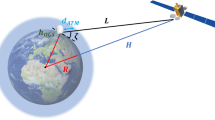Abstract
Channel Capacity is of primary importance in broadband fixed wireless access (bfwa) networks due to the ever increasing demand for multimedia services and the possibility of providing wireless Internet. One of the major factors limiting capacity in such systems is interference originating from adjacent terrestrial applications belonging to the same bfwa network or to another. Moreover, the performance of broadband fixed wireless access links operating above 10 GHz is predominantly controlled by rain attenuation. The purpose of this paper is the presentation of a physical model for the evaluation of the fraction of the time where the capacity distribution of a broadband fixed wireless access channel under rain fade conditions suffering from co-channel interference, non-exceeds a specified level in (bps/Hz). The proposed analysis examines the capacity distribution properties focusing on the spatial inhomogeneity of rainfall medium. The impact of various operational and geometrical parameters on the performance of interfered broadband wireless access channel capacity distribution is investigated through extended simulations.
Résumé
La capacité de canal est d’une importance primordiale dans les réseaux d’accès radio-électrique à large bande par suite de la demande croissante en services multimédias et de la possibilité de fournir un accès sans fil à l’internet. L’un des facteurs principaux limitant la capacité dans ces réseaux est le brouillage provenant d’applications terrestres voisines appartenant au même réseau d’accès ou à un autre. De plus, la qualité des liaisons fonctionnant au-dessus de 10 GHz est déterminée principalement par l’affaiblissement dû à la pluie. Cet article présente un modèle physique pour évaluer la fraction du temps pendant laquelle la capacité d’une liaison fixe à large bande, en présence d’affaiblissement dû à la pluie et de brouillage dans le canal, ne dépasse pas un niveau spécifié en bit/s. Hz. Il analyse la répartition de la capacité en insistant sur l’hétérogénéité spatiale de la pluie. L’effet de divers paramètres opérationnels et géométriques sur la répartition de la capacité est étudiée par simulation.
Similar content being viewed by others
References
Itu-r, “Propagation data and prediction methods for the design of terrestrial broadband millimetric radio access systems operating in a frequency range of about 20–50 GHz”, Propagation in Non-Ionized Media, Rec. p. 1410–3, Geneva, 2005.
Kwok T., “Residential Broadband Internet Services and Application Requirements”, IEEE Commun. Mag., vol. 35, pp. 76–83, June 1997.
Papazian P. B., Hufford G. A., Achatz R. J., Hoffman R., “Study of the local multipoint distribution service radio channel”, IEEE Trans. Broadcast., vol. 43, no 2, pp. 175–184, June 1997.
Eklund C., Marks R. B., Stanwood K. L., Wang S., “IEEE Standard 802.16: A technical overview of the WirelessMAN air interface for broadband wireless access”, IEEE Commun. Mag., vol. 40, no. 6, pp. 98–107, June 2002.
Etsi ts 101 999 VI. 1.1, “Broadband Radio Access Networks (bran); hiperaccess; phy protocol specification”, 2002.
Fong B., Ansari N., Fong A. C. M., Hong G. Y., Rapajic P. B., “On the scalability of fixed broadband wireless access network deployment”, IEEE Radio Commun., vol. 1, no 3, pp. 12–18, September 2004.
Gong S.Q., Falconer D., “Cochannel interference in cellular fixed broadband access systems with directional antennas”, Personal Wirel. Commun., vol. 10, no 1, pp. 103–117, June 1999.
Bose R., “Improving capacity in lmds networks using Trellis Coded Modulation”, eurasip j. Wireless Commun. Networking, Issue 2, pp. 365–373, November 2004.
Ieee 802.16, “IEEE Standard for Local and Metropolitan Area Networks — Part 16: Air Interface for Fixed Broadband Wireless Access Systems”, April 2002.
Farahvash S., Kavehrad M., “Co-channel interference assessment for line-of-sight and nearly line-of-sight millimeter waves cellular lmds architecture”, Int. J. Wireless Inform. Networks, vol. 7, no 4, pp. 197–210, 2000.
Liolis K. P., Panagopoulos A. D., Corns P. G., “Use of cell-site diversity to mitigate co-channel interference in 10–66GHz broadband fixed wireless access networks”, in IEEE Radio and Wireless Symp., pp. 283–286, 2006.
Panagopoulos A. D., Kanellopoulos J. D., “Adjacent Satellite Interference Effects as applied to the Outage Performance of an Earth-Space System located in a Heavy Rain Climatic Region”, Annals of Telecommunications, vol. 57, no 9–10, pp. 925–942, 2002.
Panagopoulos A. D., Kanellopoulos J. D., “Statistics of differential rain attenuation on converging terrestrial propagation paths”, IEEE Trans. Antennas Propagat., vol. 51, no 9, pp. 2514–2517, September 2003.
Panagopoulos A. D., Kanellopoulos J. D., “Cell-site diversity performance of millimeter-wave fixed cellular systems operating at frequencies above 20 GHz”, IEEE Antennas Wirel. Propag. Lett., vol. 1, pp. 183–185, 2002.
Etsi en 301 215-3 vl.1.1, “Fixed Radio Systems; Point to Multipoint Antennas; Antennas for point-to-multipoint fixed radio systems in the 11 GHz to 60 GHz band; Part 3: Multipoint Multimedia Wireless System in the 40.5 to 43.5GHz”, Final Draft, European Standard.
Itu-r Recommendation P. 838-2, “Specific Attenuation Model for Rain for Use in Prediction Methods”, Geneva, Switzerland, 2003.
Lin S. H.), “Method for Calculating Rain Attenuation Distributions on Microwave Paths”, Bell System Technical Journal, vol. 54, no 6, pp. 1051–1086, 1975.
Itu-r Recommendation p. 837-4, “Characteristics of Precipitation for Propagation Modeling”, Geneva, Switzerland, 2003.
Author information
Authors and Affiliations
Corresponding author
Rights and permissions
About this article
Cite this article
Panagopoulos, A.D., Chatzarakis, G.E. Co-channel interference effects as applied to broadband fixed wireless access channel capacity statistical distribution. Ann. Telecommun. 62, 955–966 (2007). https://doi.org/10.1007/BF03253300
Received:
Accepted:
Issue Date:
DOI: https://doi.org/10.1007/BF03253300
Key words
- Wireless local loop
- Radio Channel
- Channel capacity
- Signal interference
- Fading
- Rain
- Millimetric wave
- Electromagnetic wave propagation
- Modeling




